In the field of reproductive sciences, the quest for optimizing in vitro fertilization (IVF) outcomes is of paramount importance. A recent study presents a groundbreaking early prediction model that promises a leap forward in assessing the potential for high-quality blastocyst development. This research, led by Ding et al., observed the interplay between ANA (antinuclear antibody) titers and baseline demographic characteristics in patients undergoing their initial IVF or intracytoplasmic sperm injection (ICSI) cycles. By accurately predicting which embryos are likely to thrive, the implications for fertility treatments could be transformative.
The study, published in the Journal of Ovarian Research, highlights the urgency and necessity of developing predictive tools in reproductive medicine. Currently, many IVF procedures depend heavily on empirical experience and intuition, leaving room for uncertainty regarding embryo quality and selection. This lack of predictive clarity can lead to increased emotional and financial costs for couples trying to conceive and emphasizes the potential value of data-driven approaches to enhance treatment success rates.
It is particularly noteworthy that the model utilizes readily available data in the form of ANA titers and demographic details. Antinuclear antibodies are autoantibodies that could indicate an immune response which may affect pregnancy outcomes. Meanwhile, demographic characteristics such as age, body mass index (BMI), and reproductive history provide crucial insights into individual patient profiles. By combining these elements, the research team embarked on creating a robust statistical model that holds promise for personalized fertility treatments.
In the trial, the researchers assessed a comprehensive cohort of participants undergoing their first IVF/ICSI cycles. By analyzing the relationship between the patients’ baseline characteristics and blastocyst development outcomes, they established critical correlations that could enhance the selection processes involved in embryo transfer. The new model aims to identify candidates for whom certain treatment paths may be more beneficial, thereby optimizing the use of medical resources.
What sets this model apart from previous approaches is its predictive nature, which can be utilized early on in the IVF process. This allows for timely interventions that could improve overall success rates. For instance, if the model indicates that a particular patient is less likely to yield high-quality embryos based on their ANA titer and demographic profile, healthcare providers can tailor their approach accordingly. This might involve recommending lifestyle adjustments, identifying the need for enhanced pre-treatment, or even considering different laboratory techniques for embryo culture.
The role of ANA titers in this context is particularly intriguing. Elevated levels of these antibodies are linked to autoimmune disorders, which can significantly impact reproductive outcomes. Historically, not enough attention has been given to these markers when planning fertility treatment strategies. However, the research from Ding et al. suggests that integrating immune profiles could lead to better-informed decisions regarding embryo transfer eligibility.
Moreover, the demographic factors taken into consideration within this model provide a holistic view of patient health beyond mere numbers. By acknowledging the interplay between biological and social determinants of health, healthcare providers can foster more inclusive approaches to reproductive treatment. This model may provide avenues for a more nuanced understanding of how different factors affect the likelihood of achieving successful pregnancies.
As the field of reproductive medicine continues to evolve, the integration of predictive analytics and machine learning into clinical practice becomes increasingly critical. This model by Ding and colleagues serves as an early example of how data science can be leveraged to make significant strides in IVF. With the potential to revolutionize patient care, early predictive models could pave the way for enhanced strategies that ensure higher rates of successful blastocyst development.
The potential ripple effects of such a model extend far beyond individual patients. As fertility clinics begin to adopt similar approaches, the cumulative improvement in data collection and analysis will likely enrich our understanding of reproductive health as a whole. Research in this domain could evolve to encompass broader populations and diverse demographic spectrums, thereby refining the application of predictive models across different contexts in reproductive care.
Nonetheless, it is essential to approach the implementation of this model with cautious optimism. As with any predictive tool, continuous validation and adaptations will be necessary to account for the complexities of individual patient experiences. The ongoing collection of longitudinal data will be vital to assess the model’s efficacy and make adjustments based on new insights.
In conclusion, the early prediction model introduced by Ding et al. represents a crucial advancement in IVF practices, intertwining immunological insights with demographic analysis. By providing a roadmap towards better embryo selection, this research highlights a future where personalized approaches in reproductive healthcare can lead to improved outcomes for couples aspiring to conceive. It sets a foundation for further explorations into the dynamics of reproductive success, ushering in an era defined by enhanced patient-centered care and scientific rigor.
Subject of Research: Early prediction model for high-quality blastocyst development based on ANA titer and baseline demographic characteristics
Article Title: An early prediction model for high-quality blastocyst development based on ANA titer and baseline demographic characteristics in the first IVF/ICSI cycle.
Article References: Ding, K., Chen, Y., Jiang, W. et al. An early prediction model for high-quality blastocyst development based on ANA titer and baseline demographic characteristics in the first IVF/ICSI cycle. J Ovarian Res 18, 250 (2025). https://doi.org/10.1186/s13048-025-01830-z
Image Credits: AI Generated
DOI: https://doi.org/10.1186/s13048-025-01830-z
Keywords: IVF, ICSI, blastocyst development, prediction model, ANA titer, demographic characteristics, reproductive health, fertility outcomes.
Tags: antinuclear antibody impact on fertilitydata-driven approaches in reproductive healthdemographic factors in IVF successearly prediction model for IVFembryo quality assessment toolsemotional costs of fertility treatmentsfinancial implications of IVFICSI cycles and embryo selectionIVF blastocyst quality predictionoptimizing in vitro fertilization outcomesreproductive medicine advancementstransformative fertility treatment strategies





